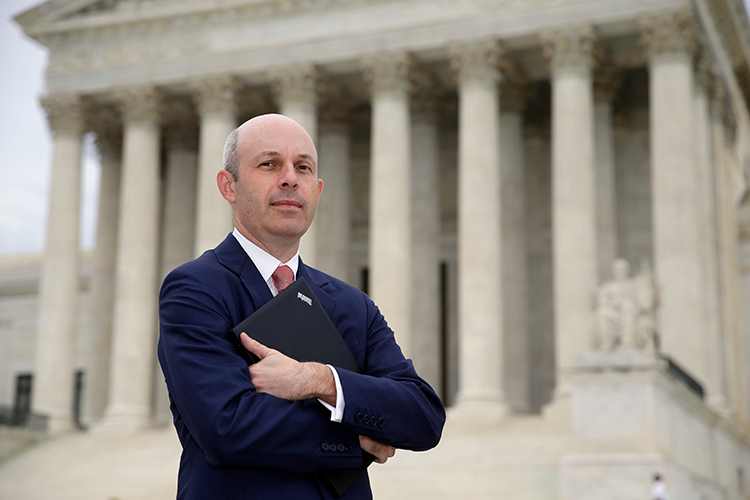Beyond Logic: The case for emotional branding for law firms

Inside Out, released in 2015, focused on the core emotions of joy, sadness, anger and fear, offering an entertaining view of how these emotions shape our thoughts and actions. The sequel introduces new emotions: anxiety, embarrassment, ennui and envy, as its protagonist. (Photo By Sthanlee B. Mirador/Sipa USA/Sipa via AP Images)
When Pixar’s Inside Out 2 hit theaters in June, audiences were once again invited to explore the inner workings of the human mind. The original film, Inside Out, released in 2015, focused on the core emotions of joy, sadness, anger and fear, offering an entertaining view of how these emotions shape our thoughts and actions.
The sequel introduces new emotions: anxiety, embarrassment, ennui and envy, as its protagonist, Riley, enters her teenage years. These movies and other cultural events suggest it is time for lawyers to turn their approach to branding inside out—keeping the logic on the inside, and letting the emotions out.
A culture of emotion
Three years before the original film, Jonathan Haidt’s 2012 book, The Righteous Mind: Why Good People Are Divided by Politics and Religion, explored how people’s beliefs are driven primarily by intuition, with reason operating mostly to justify beliefs that are intuitively obvious. Haidt uses the metaphor of a rider on an elephant to describe this relationship: The rider (reason) tries to guide the elephant (emotion), but the elephant ultimately has more power.
Businesses increasingly recognize emotion’s pivotal role in decision-making. Research in the Harvard Business Review shows emotional connections can drive significant gains. For example, a bank’s credit card designed for Millennials saw a 70% increase in use and a 40% rise in new accounts by focusing on motivators like “protect the environment” and “be the person I want to be.” Companies leveraging emotional insights often see increased customer loyalty and profitability. Law firms should adopt similar emotional branding strategies to resonate with clients.
 Paul R. Manuele.
Paul R. Manuele.The current landscape of law firm branding
Law firms typically focus their branding efforts on traits that describe themselves and the quality of their work. Common themes include expertise, track record of success, client service and innovation. While these attributes are undoubtedly important, they primarily appeal to logic and credibility rather than emotion. Law firms often develop marketing campaigns that emphasize reasons to choose their services, reflecting the analytical mindset prevalent in the legal profession.
Emotional branding in other industries
In contrast, marketers in other industries often target emotions. For example:
• Coca-Cola celebrates joy with its uplifting campaigns.
• Insurance companies often tap into fear and offer a sense of security.
• Nike still best known for its “Just Do It” slogan, has increasingly focused on fostering a sense of belonging and community.
• Luxury car brands invoke pride and achievement.
• Financial services firms offer peace of mind by emphasizing stability and performance.
These brands create deeper connections with consumers by evoking emotional responses that go beyond rational decision-making. They understand that while people may justify their choices with logic, initial decisions are often driven by emotion.
Slow adoption of emotional branding in law
The legal profession has been slow to adopt emotional branding strategies. Lawyers only gained the green light to advertise in 1977, when the U.S. Supreme Court’s decision in Bates v. State Bar of Arizona struck down prohibitions on lawyer advertising. Even then, for cultural reasons, many lawyers were uncomfortable with the idea of advertising their services and were slow to embrace the change. Also, there are legitimate ethical considerations, and strict rules established in the ABA’s Model Rules of Professional Conduct. Even when lawyers did turn to advertising, they did so in a rationalist mode. The first law firms to appeal directly to emotions were personal injury lawyers, and those appeals arguably did little to encourage lawyers at corporate firms to open up emotionally.

Strategies for implementing emotional branding in law firms
To effectively implement emotional branding, law firms can adopt the following strategies:
• Develop a brand that captures who you are: Move beyond generic phrases like “full-service firm” or “extensive experience.” Instead, create a brand message that resonates on an emotional level. For example, a headline like “The right partner makes all the difference” balances reason and emotion, suggesting that the right legal partner can instill confidence.
• Use storytelling: Share client success stories that focus not only on the legal outcome but on the emotional journey and impact on the client’s life. This approach helps potential clients envision themselves in similar situations and feel a connection to your firm.
• Visual messaging: Move away from clichéd images such as scales of justice or courthouse columns. Instead, use visuals that evoke the emotions you want to associate with your brand.
• Content with an emotional boost: Tell your firm’s story in a way that draws readers in emotionally. Explain what motivates your lawyers, why clients trust you, and how your work impacts lives and communities.
• Focus on emotional benefits, not just logical ones: While it’s important to highlight your legal expertise, also emphasize the emotional benefits clients receive, such as the peace of mind that comes from being supported throughout the legal process or the confidence that they can avoid or solve complex problems.
• Incorporate emotional trigger words: In your marketing copy, use words that elicit emotions such as achieve, imagine, confidence, together and trust.
• Align your brand with values: Modern consumers, including those seeking legal services, often want to work with brands that align with their values. Highlight your firm’s commitment to social responsibility, diversity and inclusion, and community involvement to create an emotional connection based on shared values.
Challenges and considerations
Implementing emotional branding in law firms comes with challenges:
• Regulatory compliance: Ensure all emotional branding efforts comply with legal advertising regulations. Although each state has its own rules, they tend to hew closely to the ABA model rules.
• Maintaining professionalism: Strike a balance between emotional appeal and the professional image expected of legal services.
• Authenticity: Any branding must be genuine and reflected in the actual client experience.
Embracing the emotional dimension
As Inside Out 2 reminds us, emotions play a crucial role in our decision-making. By recognizing this fundamental aspect of human nature, law firms can develop marketing strategies that resonate on both emotional and rational levels. Incorporating elements of emotional branding can help firms create deeper connections with audiences, differentiate themselves in a crowded market and drive growth. The key is to balance emotional appeal with the credibility and expertise that form the foundation of legal services. By mastering this balance, law firms can promote brands that truly resonate with the complex, emotion-driven decision-makers that hire them.
Paul R. Manuele is a marketing and business development professional in the legal industry. Connect with Manuele on LinkedIn.
Mind Your Business is a series of columns written by lawyers, legal professionals and others within the legal industry. The purpose of these columns is to offer practical guidance for attorneys on how to run their practices, provide information about the latest trends in legal technology and how it can help lawyers work more efficiently, and strategies for building a thriving business.
Interested in contributing a column? Send a query to [email protected].
This column reflects the opinions of the author and not necessarily the views of the ABA Journal—or the American Bar Association.



